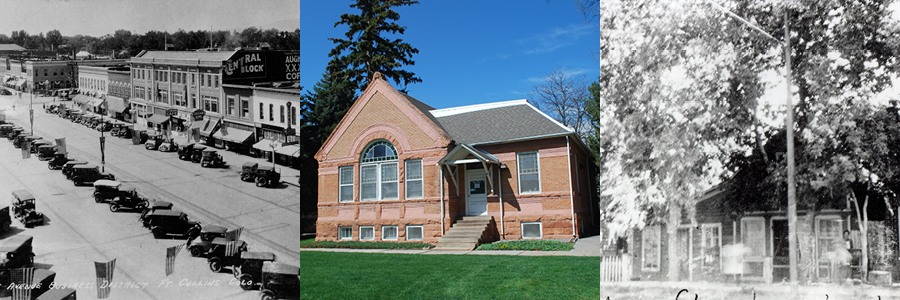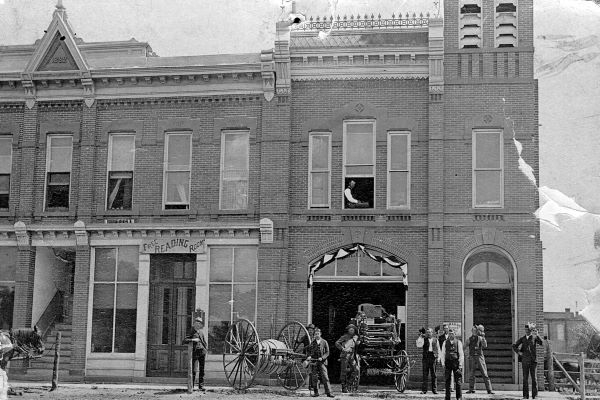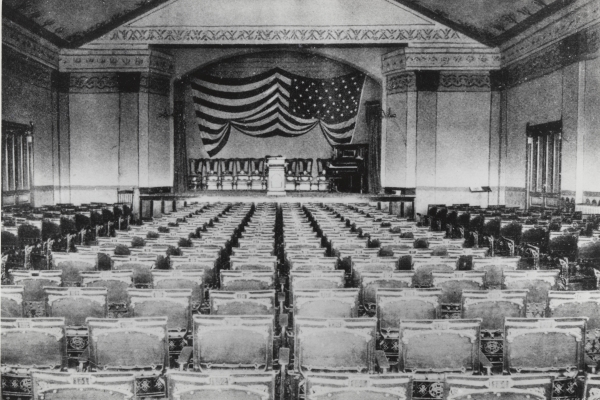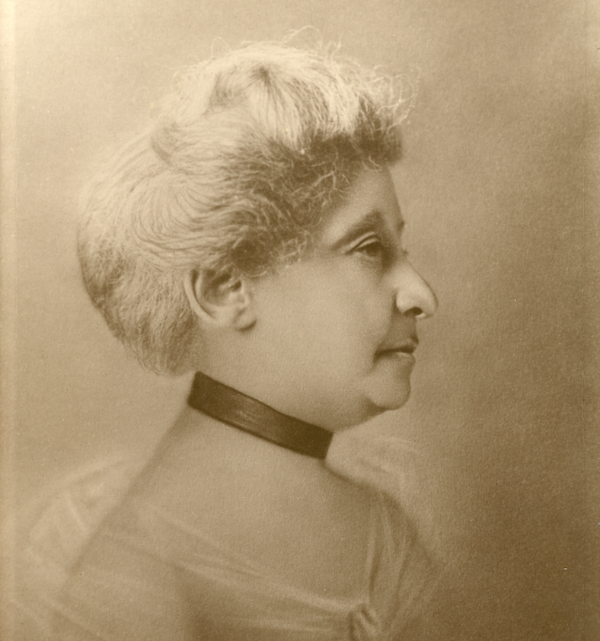From Parlors to Polling Places: Women's Suffrage in Fort Collins#
“They are not afraid to ask for what they want, and they are going to keep right on asking until they do get what they are sure they ought to have.” Mrs. W.H. Wrigley, Fort Collins Courier, May 18, 1893

From left to right: 100 block of north College Avenue, c.1929, showing the Fort Collins Opera House and Ault's Hall (H01952, Fort Collins Museum of Discovery); Routt Hall/Domestic Arts Building (Fort Collins Historic Preservation Services); Elizabeth Stone Residence on Jefferson Street (H14756, Fort Collins Museum of Discovery).
The Research: The Story of Women's Suffrage in Fort Collins
In the spring of 2020, the City of Fort Collins collaborated with CSU History graduate student Leslie Moore to research the topic of women's suffrage in Fort Collins in order to recognize places associated women's suffrage in the city. On this web page you'll find the highlights of her research and a walking tour based on her work. Want to read the full report? Click on the link below!
Want to Explore Places of the Suffrage Movement in Fort Collins? Try this Virtual Tour!
Download the Tour guide by clicking HERE.
You can also enjoy walking tour virtually by watching THIS VIDEO co-produced with Living Her Legacy as part of the HerStory FC project.
We encourage you to explore these sites on your own time, by car, bike, or on foot. Please share the street and be respectful to the privacy of the owners and residents of the homes on this tour by viewing them from the street/sidewalk only.
Explore More Women's Suffrage History
Check out the short article by Jenny Hannifin at the Fort Collins Museum of Discovery about the suffrage movement in Fort Collins leading up to 1893 by clicking HERE. The Museum also offers several activities about suffrage that you can access HERE.
You can also check out this August 6, 2020 article by Erin Udell in the Fort Collins Coloradoan about some of Fort Collins' suffragists, HERE.
Getting the Vote: Women's Suffrage in America & the West#
College Chapel at Old Main at Colorado Agricultural College (now Colorado State University). Several suffrage speeches were given here, including lectures by Dr. Theodosia Ammons. (H00136, Courtesy of the Fort Collins Museum of Discovery).
The women's suffrage movement in the United States began in the Revolutionary era as women such as Abigail Adams advocated for women's right to vote in the new republic. In the 1800s, other prominent activists such as Elizabeth Cady Stanton and Susan B. Anthony led a sustained movement for the vote. This included well known events like the Seneca Falls convention in 1848. For most of that century, Victorian-era principles dominated American culture. These concepts dictated that politics and voting were the domains of men, while women were considered the homemakers, teachers, and caretakers of society.
Want to learn more about the national suffrage movement? Check out the National Park Service website on women's suffrage by clicking below.
However, as the United States began colonizing its western territory in the late 1800s, many of those who settled began breaking down Victorian-era gender roles. In the West, this was often out of necessity. Farms, ranches, and small-town businesses required the labor of both men and women to succeed. Western land grant universities like the Colorado Agricultural College (now Colorado State University) were generally more accommodating to women, becoming some of the nation’s first co-ed institutions for higher education. This reality made denying women the vote less practical and defensible. As early as the 1860s, those promoting women’s suffrage in western states and territories gained significant ground. In 1869, the territory of Wyoming became the first to grant women the vote, followed soon thereafter by Utah territory. In 1893, Colorado became the first state to do so via a state-wide referendum. This expansion of suffrage in Colorado was mainly limited to white (including Hispanic) and black women. The United States denied Chinese immigrants, including women, citizenship and voting rights in 1882 with the passage of the Chinese Exclusion Act, which would not be reversed until the 1940s. Native Americans, including Native women, technically gained voting rights in 1924, but actual access varied state by state – Native people on reservations in Colorado didn’t have their voting rights protected until the Voting Rights Act of 1970, after which Colorado Governor John A. Love modified the State Constitution by proclamation to comply with the act. Despite the suffrage movement’s short-comings, the first steps for women’s suffrage in the 1800s and early 1900s paved the way for future advances and opportunities for women in civic life.
Gaining Women's Suffrage: Fort Collins & Colorado, 1880-1920#
Colorado holds the title as the first state where women won the vote at the ballot box, doing so in 1893. However, other western territories preceded Colorado in granting women suffrage, including Wyoming in 1869 (where women retained their voting rights after statehood in 1890), and Utah in 1870 (which became a state in 1896). Colorado suffragists made several attempts to secure women the vote but most early efforts failed. In 1870, then Territorial Governor Edward McCook urged territorial lawmakers to follow Wyoming’s lead and grant women the vote but the territorial legislature rejected the idea. During the state convention in 1875-1876, delegates Henry P. Bromwell of Denver and Agapito Vigil of Huerfano and Las Animas Counties, called for women’s enfranchisement. In fact, language in the original draft of the Colorado Constitution included this:
“The General Assembly shall, at the first session thereof, and may at any subsequent session, enact laws to extend the right of suffrage to women of lawful age, and otherwise qualified according to the provisions of this Article. No such enactment shall be of effect until submitted to the vote of the qualified electors at a general election, nor unless the same be approved by a majority of those voting thereon.”
However, Bromwell and Huerfano were outvoted by other delegates and the legislature did not include the language in the adopted Constitution. Advocates tried again in 1877 with a state-wide referendum on women’s suffrage, but failed, largely due to significant opposition by men in Denver, mining communities, and in the predominantly Hispanic southern counties.
Success came in 1893. After sixteen years of steady work by suffrage organizers across the state, Colorado women won the vote in a statewide election.
Why 1893?
Suffrage leaders in Colorado, many of them members of the Colorado Non-Partisan Equal Suffrage Association, organized for the 1893 election due to several factors. Pro-suffrage sentiment in the largely Hispanic southeastern counties had shifted completely, with women in southern Colorado threatening their anti-suffrage state senator. The Governor at the time, Davis Waite, and former governor John Routt, both supported women’s suffrage.
Why Colorado?
Western states like Colorado had several reasons, both cultural and political, to support women’s suffrage. In more sparsely populated states, granting women the vote meant more seats in Congress, which meant more influence over national affairs. Hispanic men, who at the time largely opposed women’s suffrage, were a smaller percentage of the state’s population than they had been in the 1870s. The state’s female population, although still much fewer than the men, comprised 30 percent of what would become the electorate. Anti-immigration sentiment also meant that many White, Anglo Coloradoans were concerned about the electoral influence of newcomers from different parts of the world, and saw enfranchisement, especially for Anglo women, as a way to counterbalance that. Unfortunately, anti-immigrant sentiment proved a powerful force in convincing Colorado men to vote yes to women’s suffrage in 1893.
Although the cultural and political differences between 1877 and 1893 in Colorado were important, so too was the hard work of pro-suffrage advocates throughout the state, both men and women. Journalists like Ellis Meredith and Minnie Reynolds wrote columns in favor of suffrage to convince readers of the Rocky Mountain News. Women across the state like Dr. Ethel Strasser in Grand Junction, Dr. Anna Chamberlain in Colorado Springs, and Dr. Jessie Hartwell in Salida spoke and organized in their respective communities. Martha Pease, the president of the Equal Suffrage Association organized statewide efforts to convince voters. National leaders lent their skills in Colorado as well, most notably with Carrie Chapman Catt’s statewide speech tour on behalf of the National American Woman Suffrage Association (NAWSA). While the suffrage movement, both locally, and nationally, suffered from racism and bigotry, organizing by Black Colorado women like Elizabeth Piper Ensley and Hispanic Colorado women in the southern counties of the state were also critical to success. Ensley, the daughter of formerly enslaved parents, moved to Denver with her husband in 1887 and became a prominent advocate for civil rights for women and Black Coloradoans. She worked for the Colorado Equal Suffrage Association starting in 1890, becoming the treasurer, and was a correspondent for the National Association of Colored Women.
Fort Collins played an important role in promoting women’s suffrage in 1893. Community leaders such as Elizabeth Stone, Sarah Corbin, Eliza Tannar, and Lucy McIntyre formed local organizations, held debates and meetings in their homes, and pressured local and state government for reform. Elizabeth Stone, credited as one of the founders of Fort Collins, Eliza Tannar, and others formed a local chapter of the Women’s Christian Temperance Union (WCTU), one of the key organizations that campaigned for suffrage in 1893, and the nation for the Nineteenth Amendment in 1919. The organization met and held events at several places around the region, including schools, churches, and both Ault’s Hall and the Opera House on College Avenue. Lucy McIntyre formed the Chautauqua Circle, a local organization that discussed important political and social issues, particularly women’s suffrage. Sarah Corbin hosted pro-suffrage meetings at her home at 402 Remington Street as well as a four-week course to educate women about effective voting after the 1893 state-wide suffrage victory. These women worked alongside dozens of Fort Collins women and men who hosted meetings, gave speeches, and put pressure on local and state officials to open the vote to women.

City Hall, c.1882. Alice Edwards was elected as an alderwoman to the Fort Collins Town Council in 1894 and is believed to be the first woman elected to municipal office in Colorado. She served in the upper story of the building where the town's offices were located (H00188, Courtesy of the Fort Collins Museum of Discovery).
After women won the vote in Colorado, several stepped into new leadership roles, either in the community, or to advocate for national suffrage in Washington. Alice Edwards, a downtown resident and member of the WCTU, won election as a town alderwoman in 1894 and appears to have been the first woman in Colorado to hold a local elected office. Women like Mrs. Edwards who stepped into leadership roles were instrumental in Fort Collins passing prohibition within town limits in 1896. Theodosia Ammons developed a domestic arts program for women at Colorado Agricultural College (CAC, now Colorado State University) and was a state and national spokeswoman for suffrage until her death in 1907. The movement included men as well, including Harlan Thomas, a local draughtsman, architect, and former student at CAC who gave several speeches throughout the region in favor of suffrage in the months leading up to the 1893 election. Dr. Barton Aylesworth, president of CAC from 1899 to 1909, became a professional speaker for the WCTU and advocated for national suffrage in 1909 and 1910. His work was part of a larger national effort that culminated in the ratification of the Nineteenth Amendment to the U.S. Constitution in August of 1920.
These Fort Collins residents took actions, both large and small, to make women’s suffrage a reality in Colorado in 1893 and across the nation with the ratification of the Nineteenth Amendment in 1920. A century later, we look back on their efforts and achievements to celebrate the influence they had on our lives today. Check out the links and information below to learn more.
HerStory FC
During July and August of 2020, organizations in the Fort Collins area celebrated and discussed the topic of women's suffrage and what it has meant to the women who have called northern Colorado home. Check out some of the online information brought to you by Living Her Legacy and the City of Fort Collins:
- "From Parlors to Polling Places" - part of the HerStory FC project partnership between Living Her Legacy and the City. To access the video, CLICK HERE.
- "From Parlors to Polling Places to Downtown!" - part of the HerStory FC project partnership between Living Her Legacy and the City. To access the video, CLICK HERE.
- "Women Speak," a play directed by local author Barbara Fleming about the women's suffrage movement. To access the video, CLICK HERE.
Suggested Reading and Resources#
- Beaton, Gail M., Colorado Women: A History, (Boulder: University Press of Colorado, 2012).
- Colorado Encyclopedia, “Women’s Suffrage Movement,” https://coloradoencyclopedia.org/article/womens-suffrage-movement
- Fort Collins Museum of Discovery, History Connection, https://history.fcgov.com/
- History Colorado, “The Road to the Vote,” by Leslie Karnauskas, Nov. 7, 2019, https://www.historycolorado.org/story/womens-history/2019/11/07/road-vote
- National Park Service, “Colorado and the 19th Amendment,” https://www.nps.gov/articles/colorado-and-the-19th-amendment.htm
Click below to learn more about a wide variety of Fort Collins history topics developed by Historic Preservation Services.

